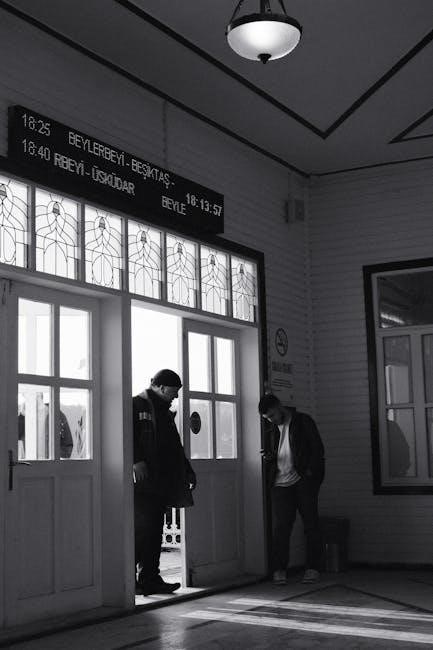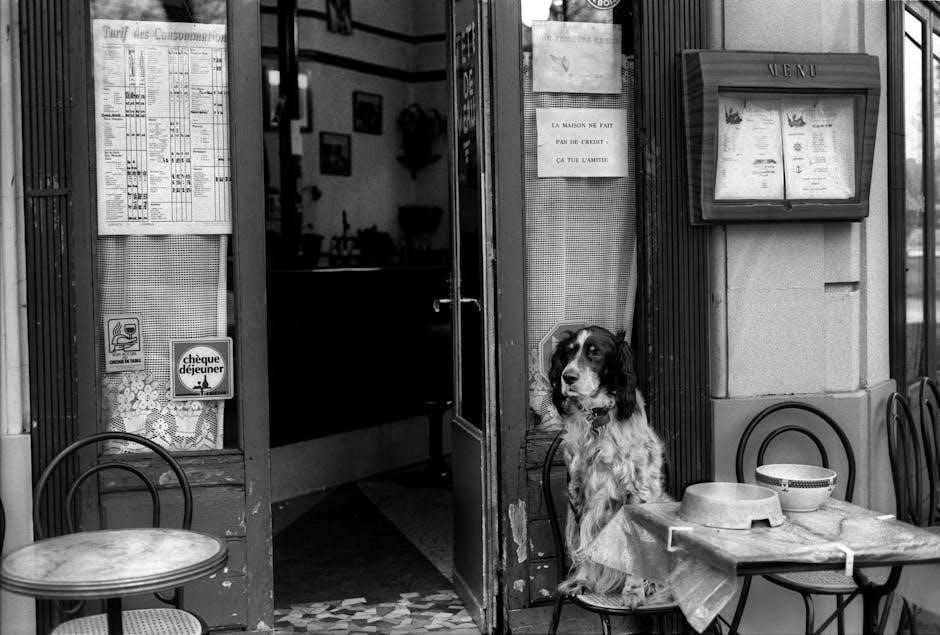
Samuel Beckett’s “Waiting for Godot” is a cornerstone of the Theatre of the Absurd. The play presents two characters, Vladimir and Estragon, endlessly waiting for someone named Godot who never arrives, highlighting life’s meaninglessness.
Overview of the Play and Its Absurdist Nature
“Waiting for Godot,” penned by Samuel Beckett, stands as a defining work within the Theatre of the Absurd. The play centers around Vladimir and Estragon, two characters perpetually waiting on a country road for the enigmatic Godot. Godot’s non-arrival underscores the play’s core themes of existential angst, the futility of human endeavor, and the cyclical nature of time. Through repetitive dialogue and absurd situations, Beckett challenges conventional theatrical norms, presenting a bleak yet darkly humorous view of the human condition, prompting audiences to question the meaning of existence itself.
“Waiting for Godot” features Vladimir and Estragon, two tramps who represent different aspects of humanity. Their co-dependent relationship is central to exploring the play’s themes of existence and waiting.
Vladimir and Estragon: The Two Main Characters
Vladimir, often called Didi, is the more intellectual and responsible of the pair, trying to maintain order and purpose in their futile wait. Estragon, or Gogo, is more concerned with immediate physical comforts, like his boots and sleeping. Their contrasting personalities create a dynamic where they rely on each other for support and companionship, highlighting the human need for connection even in a seemingly meaningless world. They bicker and reconcile, showing a complex relationship built on shared history and mutual dependence, essential for navigating their absurd reality.
Characters and Their Interactions
Pozzo and Lucky: Exploring Their Dynamic
Pozzo and Lucky present a master-slave relationship that explores themes of power, cruelty, and dependence. Pozzo is the domineering master, while Lucky is his subservient slave, burdened with carrying his belongings and obeying his commands. Their dynamic shifts throughout the play, reflecting the changing nature of power and the potential for both dominance and submission within human relationships. Lucky’s famous monologue showcases the absurdity of intellectual pursuits under oppressive conditions, while Pozzo’s blindness symbolizes a loss of empathy and understanding, making their interactions disturbingly captivating.
“Waiting for Godot” profoundly explores the absurdity of human existence. The characters’ endless waiting, repetitive dialogue, and lack of purpose underscore the inherent meaninglessness and uncertainty of life in a chaotic universe.
The Absurdity of Existence
Samuel Beckett’s “Waiting for Godot” epitomizes the Theatre of the Absurd, showcasing human existence as inherently meaningless. Vladimir and Estragon’s cyclical conversations and futile wait for Godot highlight the lack of rational order in the universe. Their actions, devoid of purpose, reflect a world where traditional values and beliefs have crumbled, leaving individuals adrift in a chaotic reality where hope and despair intertwine. The play challenges audiences to confront the uncomfortable truths about existence.
The Concept of Waiting and Time
Waiting is central to “Waiting for Godot,” with Vladimir and Estragon perpetually anticipating Godot’s arrival. Time becomes distorted and cyclical as they repeat routines and conversations. The characters struggle to fill the void of their existence, highlighting the human tendency to seek purpose in the future. The open-ended nature of their wait emphasizes the uncertainty of life, where the promise of fulfillment may never materialize, leaving them trapped in a monotonous present.

Themes in “Waiting for Godot”
Meaninglessness and Lack of Purpose
“Waiting for Godot” explores the profound lack of inherent meaning in human existence. Vladimir and Estragon’s endless wait for a figure who never appears underscores the futility of their actions. Their repetitive dialogue and circular routines emphasize the absence of progress or purpose. The play suggests that life is inherently absurd, devoid of intrinsic significance, and that individuals are left to create their own meaning in a world that offers none. This highlights the human struggle to find purpose in a seemingly indifferent universe.
Godot represents elusive hope or meaning. The characters’ relentless anticipation suggests humanity’s search for purpose. Godot’s absence underscores the potential futility of such quests, leaving the audience to ponder what, if anything, he truly signifies.
Godot as a Symbol of Hope or Meaning
In “Waiting for Godot,” the eponymous character functions as a complex symbol open to interpretation. He can be seen as representing hope, salvation, or a higher power that never arrives. Vladimir and Estragon’s unwavering anticipation of Godot’s arrival highlights humanity’s inherent desire for meaning and purpose in an seemingly indifferent universe. His continued absence prompts contemplation on the nature of hope and the potential for disillusionment when expectations are perpetually unmet. This ambiguity fuels the play’s enduring power, challenging audiences to confront their own existential questions.
The Tree as a Symbol of Life and Despair
The lone tree in “Waiting for Godot” serves as a potent symbol throughout the play, fluctuating between representations of life and despair. In Act One, it is barren, reflecting the desolation of Vladimir and Estragon’s existence. However, by Act Two, it sprouts a few leaves, suggesting a glimmer of hope or renewal. This subtle change highlights the cyclical nature of their waiting and the ambiguous potential for change within their seemingly stagnant lives. The tree’s sparse foliage can also symbolize the fragility and precariousness of life in an absurd world.
Symbolism in “Waiting for Godot”
The Boots and Hats: Symbols of Routine and Identity
The recurring motifs of boots and hats in “Waiting for Godot” represent the characters’ adherence to routine and their struggles with identity. Estragon’s ill-fitting boots, which he repeatedly attempts to remove, symbolize the discomfort and constraints of his existence. Vladimir’s hat, which he constantly adjusts, may represent his attempts to maintain order and control in a world devoid of meaning. The repetitive actions involving these items underscore the characters’ dependence on habitual patterns as a means of coping with the absurdity and uncertainty of their situation, highlighting a search for self.
“Waiting for Godot” employs repetitive dialogue and a circular structure. This emphasizes the characters’ stagnation and the play’s central theme: the futility of waiting for an arrival that never happens, showcasing existential angst.
Repetitive Dialogue and Circular Structure
Samuel Beckett masterfully crafts “Waiting for Godot” with repetitive dialogue, mirroring the characters’ unchanging circumstances and the cyclical nature of their existence. Vladimir and Estragon’s conversations often return to the same topics, emphasizing their inability to escape their routine. The play’s structure, lacking a clear beginning, middle, or end, further reinforces the sense of stagnation and the absence of progress. This circularity highlights the absurdist theme of life’s meaninglessness and the futility of their endless wait, trapping them in a perpetual loop of anticipation and disappointment.

The Play’s Structure and Language
The Use of Silence and Pauses
In “Waiting for Godot,” Samuel Beckett employs silence and pauses as powerful dramatic tools, amplifying the play’s themes of existential emptiness and the characters’ inability to connect meaningfully. These moments of quiet underscore the lack of purpose and the weight of their endless waiting. The silences create a palpable sense of discomfort and highlight the unspoken anxieties and uncertainties that plague Vladimir and Estragon. They also serve to emphasize the breakdown of communication and the difficulty of finding genuine connection in a meaningless world, leaving the audience to contemplate the void.
Staging “Waiting for Godot” presents unique challenges. The play’s abstract nature and lack of traditional plot demand creative interpretations. Directors must navigate the delicate balance between absurdity and emotional resonance.
Challenges in Staging the Play
“Waiting for Godot” poses numerous challenges for directors and actors alike. Its minimalist setting, repetitive dialogue, and ambiguous characters require a nuanced approach. The play’s inherent lack of traditional dramatic structure demands innovative staging techniques to maintain audience engagement. Interpreting the meaning behind the absurdity, and conveying it effectively, is paramount. Balancing humor and despair, while remaining true to Beckett’s vision, tests the creativity of any production team. Furthermore, capturing the play’s rhythm and pacing are critical for a successful performance, ensuring the audience experiences the intended feeling of existential unease.

“Waiting for Godot” in Performance
Notable Productions and Interpretations
Throughout its history, “Waiting for Godot” has seen various groundbreaking productions. One notable interpretation involved an all-black cast, highlighting themes of oppression and hope. Another production set the play in a post-apocalyptic wasteland, emphasizing the characters’ isolation and desperation. Some directors have chosen to focus on the comedic aspects, while others emphasize the play’s philosophical depth. A production in a prison resonated deeply with inmates, reflecting their own sense of waiting and confinement. These diverse approaches demonstrate the play’s enduring power to provoke thought and inspire artistic exploration, solidifying its place in theatrical history.
Critical Reception and Interpretation
“Waiting for Godot” initially baffled audiences and critics. Some found it meaningless and frustrating, while others recognized its profound exploration of the human condition and the absurdity of existence, sparking considerable debate.
Initial Reactions and Controversy
The premiere of “Waiting for Godot” stirred a maelstrom of conflicting opinions. Many audience members, accustomed to traditional narrative structures, found the play bewildering and frustrating. Some critics dismissed it as nonsensical and pointless, unable to discern any clear message or plot progression. However, other voices emerged, recognizing the play’s daring experimentation and its profound exploration of existential themes. This division in opinion fueled intense debate about the nature and purpose of theatre, cementing “Waiting for Godot’s” place as a controversial yet significant work.
Later Interpretations and Analysis
Over time, “Waiting for Godot” has been subjected to diverse interpretations, moving beyond initial bewilderment. Some view Godot as a symbol of God, hope, or meaning, while others see him as a representation of societal expectations or even death. Critics have explored the play’s philosophical underpinnings, linking it to existentialism and nihilism. The cyclical nature of the dialogue and the characters’ reliance on routine have been analyzed as reflections of the human condition, trapped in repetitive patterns and searching for purpose in a seemingly absurd world.
“Waiting for Godot” significantly impacted the Theatre of the Absurd. It is characterized by illogical situations, meaningless dialogue, and characters trapped in futile cycles, reflecting a sense of alienation and the breakdown of traditional values.
Impact on the Theatre of the Absurd
“Waiting for Godot” profoundly impacted the Theatre of the Absurd, becoming a defining work of the movement. Its stark portrayal of meaninglessness, repetitive dialogue, and circular structure challenged conventional dramatic forms. The play’s influence is seen in subsequent works that explore existential themes, question societal norms, and embrace non-linear narratives. It inspired playwrights to experiment with language, character development, and stagecraft, solidifying its place as a pivotal piece in theatrical history and a touchstone for absurdist expression. Its legacy continues to shape contemporary drama.
The Play’s Influence on Literature and Theatre
Influence on Subsequent Playwrights
“Waiting for Godot” has exerted a significant influence on subsequent playwrights, inspiring them to explore themes of existentialism, alienation, and the search for meaning in a seemingly meaningless world. Its innovative use of language, repetitive dialogue, and unconventional structure has encouraged playwrights to experiment with form and content. Playwrights have adopted Beckett’s minimalist style, his focus on character relationships, and his exploration of human condition. The play’s impact can be seen in works that challenge traditional narrative conventions and embrace the absurd, contributing to the evolution of modern drama.
“Waiting for Godot” is widely available in PDF format online. Numerous websites offer free downloads of the play, allowing easy access to Beckett’s tragicomedy for study and personal enjoyment.

Availability of “Waiting for Godot” in PDF Format
Sources for Downloading the Play in PDF
Finding “Waiting for Godot” in PDF format is relatively straightforward due to its widespread availability. The Internet Archive offers a downloadable version, as do many educational websites and online libraries. Ensure the source is reputable to guarantee a complete and accurate text. Some sites may offer different versions or translations, so choose one that suits your specific needs. Always be mindful of copyright restrictions when accessing and distributing digital copies. Several online platforms provide access to the play’s script for academic or personal study.
“Waiting for Godot” remains profoundly significant, prompting ongoing discussion and inspiring diverse interpretations. Its exploration of existential themes, particularly the absurdity of human existence and the futility of waiting for meaning, continues to resonate with audiences. The play’s innovative structure and language have influenced countless playwrights. Access to readily available PDF versions ensures its continued study and performance, solidifying its place as a pivotal work in modern literature and theatrical history. The play challenges us to confront the essential questions of life and purpose.